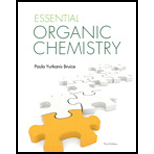
(a)
Interpretation:
The major product of a Fridel-Crafts alkylation with the given alkyl chloride has to be stated.
Concept Introduction:
The Friedel-Crafts alkylation reaction is an example of electrophilic aromatic substitution reaction. This reaction takes place between benzene (mostly) and an
In Friedel-Crafts alkylation, the major product is determined by stabilization of an electrophile (a carbocation). A tertiary carbocation is more stable as compare to the secondary and primary carbocation and thereby tertiary carbocation gives major product.
(b)
Interpretation:
The major product of a Fridel-Crafts alkylation with the given alkyl chloride has to be stated.
Concept Introduction:
The Friedel-Crafts alkylation reaction is an example of electrophilic aromatic substitution reaction. This reaction takes place between benzene (mostly) and an alkyl halide in the presence of Lewis acid catalyst. The mechanism of the reaction comprises three steps. The first step is generation of an electrophile (a carbocation). The second step is addition of electrophile on the benzene ring. The third step is deprotonation to yield an alkylated product.
(c)
Interpretation:
The major product of a Fridel-Crafts alkylation with the given alkyl chloride has to be stated.
Concept Introduction:
The Friedel-Crafts alkylation reaction is an example of electrophilic aromatic substitution reaction. This reaction takes place between benzene (mostly) and an alkyl halide in the presence of Lewis acid catalyst. The mechanism of the reaction comprises three steps. The first step is generation of an electrophile (a carbocation). The second step is addition of electrophile on the benzene ring. The third step is deprotonation to yield an alkylated product.
(d)
Interpretation:
The major product of a Fridel-Crafts alkylation with the given alkyl chloride has to be stated.
Concept Introduction:
The Friedel-Crafts alkylation reaction is an example of electrophilic aromatic substitution reaction. This reaction takes place between benzene (mostly) and an alkyl halide in the presence of Lewis acid catalyst. The mechanism of the reaction comprises three steps. The first step is generation of an electrophile (a carbocation). The second step is addition of electrophile on the benzene ring. The third step is deprotonation to yield an alkylated product.
Trending nowThis is a popular solution!

Chapter 7 Solutions
Pearson eText for Essential Organic Chemistry -- Instant Access (Pearson+)
- Which compound will undergo solvolysis most rapidly? A. t-hexyl-I B. t-hexyl-OSO2CH3 C. t-hexyl-F D. t-hexyl-OSO2CF3arrow_forwardWhich of the following does not convert a primary alcohol into a good leaving group for an SN2 reaction? a. SOCI2/pyridine b. TSCI/pyridine c. PBr3 d. Nal aarrow_forwardWhich of the following alkyl halides undergoes the fastest solvolysis reaction with formic acid, HCOOH? a. tert-butyl fluoride b. tert-butyl chloride c. tert-butyl bromide d. tert-butyl iodide a Obarrow_forward
- What is the major product of the reaction of 1 mol of propyne with each of the following reagents? a. HBr (1 mol) e. aqueous H2SO4, HgSO4 h. H2/Lindlar catalyst b. HBr (2 mol) f. R2BH in THF followed by i. sodium amide c. Br2 (1 mol)/CH2Cl2 H2O2/HO-/H2O j. the product of part i followed by d. Br2 (2 mol)/CH2Cl2 g. excess H2, Pd/C 1-chloropropanearrow_forward1. Which of the following alkyl halides is the second most reactive one in a SN2 reaction? Br Br Br CI 2. Which of the following leaving group is the poorest one? CH3O CF3SO3 CH3OH CH3™ 3. Write/draw the most reactive alkyl halide in a solvolysis reaction with a molecular formula of C4H9C1arrow_forwardChlorocyclohexane + NaOH in the presence of ethanol at high temperature will form which product at a higher yield? a. cyclohexanol b. cyclohexene C. none of the abovearrow_forward
- 1. Which alkyl bromide is the best choice to use as a reagent in a Williamson ether synthesis of 2-propoxybutane? A Br A B OCH3 2. What is the product of this alkoxymercuration-demercuration reaction? B OCH₂ C H₂CO Br 1. Hg(OAc)2, CH3OH 2. NaBH4 C HyCO. D Darrow_forwardRank the compounds in each group in order of increasing reactivity in nucleophilic acyl substitution.a. C6H5CO2CH3, C6H5COCl, C6H5CONH2 b. CH3CH2CO2H, (CH3CH2CO)2O, CH3CH2CONHCH3arrow_forward1. Which of these reagents can generate the desired product through ozonolysis?arrow_forward
- Which of the following molecules can be product of the the given reaction? a. b. -CH2Br + CH3CH₂Br 2Na/dry ether CH2CH2CH2CH3 CH3CH2CH3 очно-гноо d. -CH2CH3 e. CH3CH2CH2CH2CH3arrow_forwardB, C, and D, please. With reagents listed, I don't need the mechanism's. Thank you.arrow_forwardThe best way to prepare 1,2-dibromopropane is to treat a.propene with Br2. b.propyne with excess HBr. c.propyne with excess HBr in the presence of peroxides. d.propyne with excess Br2.arrow_forward
 ChemistryChemistryISBN:9781305957404Author:Steven S. Zumdahl, Susan A. Zumdahl, Donald J. DeCostePublisher:Cengage Learning
ChemistryChemistryISBN:9781305957404Author:Steven S. Zumdahl, Susan A. Zumdahl, Donald J. DeCostePublisher:Cengage Learning ChemistryChemistryISBN:9781259911156Author:Raymond Chang Dr., Jason Overby ProfessorPublisher:McGraw-Hill Education
ChemistryChemistryISBN:9781259911156Author:Raymond Chang Dr., Jason Overby ProfessorPublisher:McGraw-Hill Education Principles of Instrumental AnalysisChemistryISBN:9781305577213Author:Douglas A. Skoog, F. James Holler, Stanley R. CrouchPublisher:Cengage Learning
Principles of Instrumental AnalysisChemistryISBN:9781305577213Author:Douglas A. Skoog, F. James Holler, Stanley R. CrouchPublisher:Cengage Learning Organic ChemistryChemistryISBN:9780078021558Author:Janice Gorzynski Smith Dr.Publisher:McGraw-Hill Education
Organic ChemistryChemistryISBN:9780078021558Author:Janice Gorzynski Smith Dr.Publisher:McGraw-Hill Education Chemistry: Principles and ReactionsChemistryISBN:9781305079373Author:William L. Masterton, Cecile N. HurleyPublisher:Cengage Learning
Chemistry: Principles and ReactionsChemistryISBN:9781305079373Author:William L. Masterton, Cecile N. HurleyPublisher:Cengage Learning Elementary Principles of Chemical Processes, Bind...ChemistryISBN:9781118431221Author:Richard M. Felder, Ronald W. Rousseau, Lisa G. BullardPublisher:WILEY
Elementary Principles of Chemical Processes, Bind...ChemistryISBN:9781118431221Author:Richard M. Felder, Ronald W. Rousseau, Lisa G. BullardPublisher:WILEY





